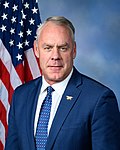A request that this article title be changed to Montana's congressional delegations is under discussion . Please do not move this article until the discussion is closed. |
Since Montana became a U.S. state in 1889, it has sent congressional delegations to the United States Senate and the United States House of Representatives. Each state elects two senators to serve for six years. Before the Seventeenth Amendment took effect in 1913, senators were elected by the Montana State Legislature. Members of the House of Representatives are elected to two-year terms. Before becoming a state, the Territory of Montana elected a non-voting delegate at-large to Congress from 1864 to 1889.
Contents
- United States Senate
- U.S. House of Representatives
- Current representatives
- Delegates from Montana Territory
- Members of the United States House of Representatives
- Key
- See also
- References
A total of 54 people have served either the Territory or State of Montana: 17 in the Senate, 32 in the House, and five in both houses. The longest-serving senator is Max Baucus, in office from 1978 to 2014. The longest-serving representative is Pat Williams, in office for 18 years from 1979 to 1997. One woman has been a member of Montana's congressional delegation, Jeannette Rankin, as a representative. She was the first woman in the United States Congress.
The current dean of the Montana delegation is Senator Steve Daines, having been a member of Congress since 2013.

















